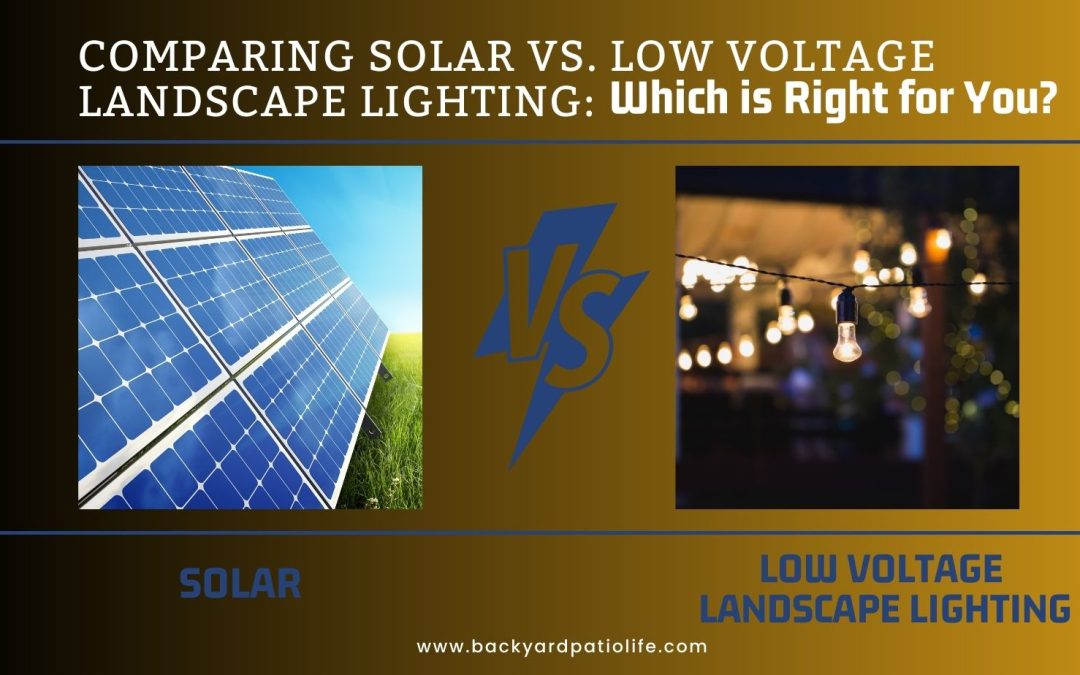==================
A Caveat and Affiliates
First off, a little caveat: within my articles you will find affiliate links, meaning if you buy them, I get a small commission. Your cost is not affected. In addition, I am an Amazon Associate and I earn from qualifying purchases on Amazon.
And yes, if I say that I recommend a product here, it means I truly believe it is a good product. I refuse to recommend any product that I have not researched and believe to be a good value.
Even better, I provide you with a very clear picture of the product, it’s use, and the probable value.
Earning your trust is important to me. I run this website myself and the commissions and donations help support the site.
Sound reasonable and fair enough? Let’s continue to the article.
==================
Landscape lighting transforms ordinary outdoor spaces into captivating and inviting areas. It accentuates the architectural features, illuminates pathways, and adds a magical touch to gardens and patios. Properly chosen landscape lighting enhances curb appeal and creates a warm ambiance for evening gatherings. Two alternatives stand out regarding lighting options: solar lights and low-voltage landscape lighting. Solar lighting relies on the sun’s energy and is a sustainable and eco-friendly option. On the other hand, low-voltage lighting systems use a transformer to reduce household voltage, providing a cost-effective and energy-efficient solution.
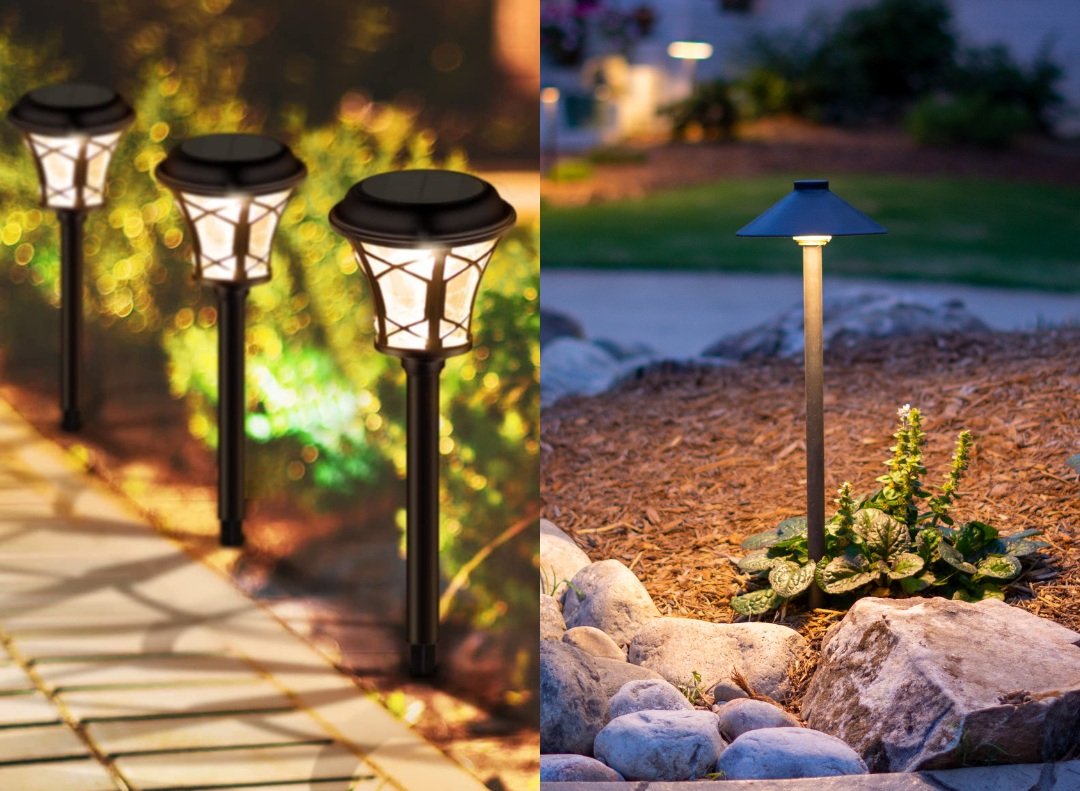
This comparison sheds light on the strengths and weaknesses of solar and low-voltage landscape lighting options. By looking at factors such as brightness, energy efficiency, installation complexity, cost, and environmental impact, we will help you make an informed decision. Whether you prefer solar-powered fixtures drawing energy from the sun’s rays or low-voltage systems buried underground, this analysis will help you find the ideal lighting solution for your outdoor space.
Solar Landscape Lighting
Solar landscape lighting is an innovative and eco-friendly lighting solution that harnesses the power of the sun to illuminate outdoor spaces. Understanding how solar lights work and their components is crucial to appreciate the advantages and disadvantages of this technology.
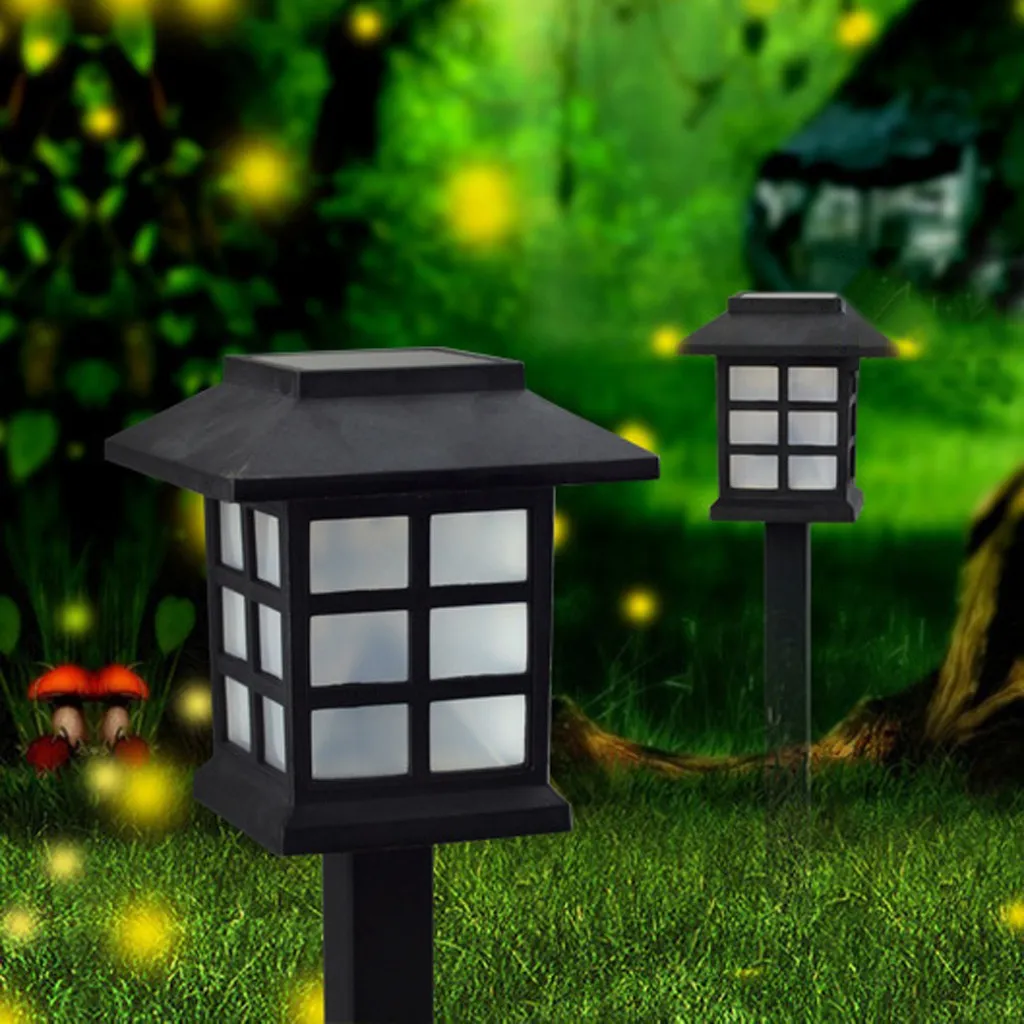
Advantages of Solar Landscape Lighting
Solar landscape lighting offers several compelling advantages, making it an appealing option for outdoor illumination.
Environmentally Friendly and Renewable Energy Sources
One of the most significant benefits of solar landscape lighting is its eco-friendly nature. Solar lights draw energy directly from the sun, converting sunlight into electricity through photovoltaic (PV) panels. This process does not release harmful greenhouse gases, making it an excellent choice for reducing carbon footprints and contributing to a sustainable environment.
Easy Installation and Mobility
Solar landscape lights are easy to install as they do not require complex wiring or access to electrical outlets. This advantage allows for greater flexibility in positioning the lights, making it ideal for areas where conventional electrical connections are challenging or costly to set up. Additionally, the mobility of solar lights allows for easy relocation as landscape design changes over time.
Reduced Operating Costs and Maintenance
Solar landscape lighting operates independently from the grid, reducing electricity consumption and lowering utility bills. Once installed, solar lights have minimal ongoing costs, as they rely on free solar energy. Moreover, solar lights require less maintenance than wired lighting systems, as no electrical components can be maintained or replaced.
Off-Grid Capabilities and Remote Locations
One of the most significant advantages of solar landscape lighting is its ability to function off-grid. This feature is particularly beneficial in remote areas or locations where accessing the electrical grid is challenging or not feasible. Solar lights can be strategically placed in these areas to provide much-needed illumination without extensive infrastructure.
Disadvantages of Solar Landscape Lighting
While solar landscape lighting offers numerous benefits but has some limitations that must be considered.
Dependence on Sunlight Availability and Weather Conditions
The primary drawback of solar landscape lighting is its reliance on sunlight. Solar panels need direct exposure to the sun to generate electricity effectively. Therefore, solar lights may experience reduced performance and shorter illumination periods in regions with frequent cloudy or rainy weather.
Initial Cost and Efficiency Concerns
The initial cost of installing solar landscape lighting can be higher than traditional wired systems. While the long-term operational price is lower due to the lack of electricity consumption, the upfront investment can be a barrier for some users. Additionally, the efficiency of solar panels may vary, affecting the overall brightness and performance of the lights.
Limited Brightness and Runtime
Solar landscape lights may provide a different brightness level than wired lights, especially during periods of low sunlight. As a result, they might be less suitable for areas that require intense illumination, such as high-traffic pathways or security-sensitive zones. Furthermore, the runtime of solar lights may be limited at night, depending on the energy stored during the day.
Durability and Lifespan Considerations
Solar landscape lighting components, including batteries and solar panels, have a finite lifespan. Over time, exposure to harsh weather conditions can degrade their performance. Regular maintenance and replacements may be necessary to ensure optimal functionality.
Low Voltage Landscape Lighting
Low-voltage landscape lighting is famous for illuminating outdoor spaces with energy-efficient, cost-effective lighting solutions. This type of lighting system operates on a lower voltage than traditional mains voltage lighting, providing numerous advantages that make it a preferred option for homeowners and landscapers.

Advantages of Low Voltage Landscape Lighting
Low-voltage landscape lighting offers several benefits that cater to various lighting needs, making it a versatile and reliable option for enhancing outdoor spaces.
Energy-Efficient and Cost-Effective
One of the primary advantages of low-voltage landscape lighting is its energy efficiency. By operating at lower voltages, these lighting systems consume less electricity, reducing energy costs. Additionally, using energy-efficient LED bulbs in low-voltage fixtures further enhances their cost-effectiveness, as they have a longer lifespan and require less frequent replacements.
Versatility in Design and Lighting Effects
Low-voltage landscape lighting provides a wide range of design possibilities. With the ability to use smaller fixtures and flexible wiring, it allows for more creative and discreet placement throughout the landscape. This versatility provides for precise highlighting of focal points, plants, and architectural features, creating stunning visual effects and ambiance in outdoor spaces.
Longer Lifespan and Durability
Low-voltage landscape lighting fixtures are designed to withstand outdoor elements and have a longer lifespan than their higher-voltage counterparts. The lower operating temperature of LED bulbs in low-voltage lighting contributes to their extended life expectancy, reducing maintenance costs and the need for frequent replacements.
Constant and Reliable Illumination
Low-voltage landscape lighting systems utilize transformers to convert higher-voltage electricity to a lower voltage, ensuring a constant and reliable illumination output. This stable lighting performance ensures consistent brightness and avoids flickering, providing a safer and more enjoyable outdoor environment.
Disadvantages of Low Voltage Landscape Lighting
Despite the numerous advantages, low-voltage landscape lighting does have some limitations that should be considered when planning an outdoor lighting project.
Higher Installation Complexity
Installing low-voltage landscape lighting can be more intricate than solar lights, as it involves burying wiring and setting up a transformer to convert the power from mains voltage to low voltage. This complexity may require professional assistance, increasing the initial installation cost. Requires a Power Source and Transformers: Unlike solar landscape lighting, low-voltage systems require a nearby power source and transformers to decrease the voltage. This means the lighting system depends on a power supply, which may limit the placement of fixtures in some outdoor regions.
Limited Off-Grid Applications
Since low-voltage landscape lighting relies on a power source and transformer, it is only suitable for off-grid or remote locations with access to electricity. This limitation may restrict its use in specific outdoor settings.
Potential Voltage Drop Issues in Long Cable Runs
Low-voltage landscape lighting can experience voltage drop issues in long cable runs. Voltage drop reduces brightness in fixtures farther from the transformer, affecting the overall lighting performance. Proper wire sizing and voltage calculations are essential to mitigate this problem.
Comparison between Solar and Low Voltage Landscape Lighting
Landscape lighting plays a crucial role in enhancing the beauty and functionality of outdoor spaces. When choosing the proper lighting for landscaping, two popular options are solar landscape lighting and low-voltage landscape lighting. This comparison aims to delve into the critical aspects of these lighting methods to help homeowners and landscape designers make informed decisions.
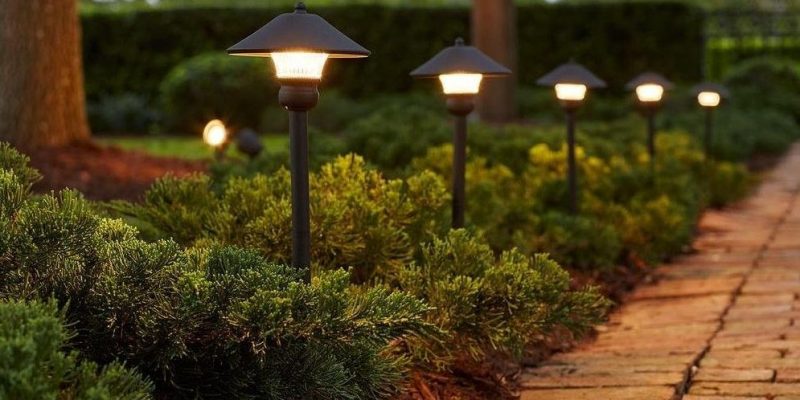
Energy Efficiency and Environmental Impact
Solar’s Renewable Energy vs. Low Voltage Efficiency
Solar landscape lighting harnesses the power of the sun to generate electricity, making it a renewable and eco-friendly option. The photovoltaic cells in solar panels convert sunlight into electrical energy, eliminating the need for conventional power sources. On the other hand, low-voltage landscape lighting relies on electricity from existing power grids, making it efficient but less environmentally friendly than solar.
Carbon Footprint and Environmental Considerations
Solar landscape lighting significantly reduces carbon emissions by utilizing clean energy from the sun. It contributes to a greener environment and helps combat climate change. In contrast, low-voltage lighting may produce carbon emissions depending on the energy sources used by the power grid. Therefore, solar lighting has a lower carbon footprint and is more environmentally sustainable.
Installation and Maintenance
Ease of Installation and Mobility
Solar landscape lighting offers unparalleled ease of installation since it operates independently of electrical wiring. No digging or burying of wires is required, making it a hassle-free process. Moreover, solar lights can be easily moved or relocated without professional assistance. On the other hand, low-voltage landscape lighting typically involves more complex installation procedures, including running wires underground and connecting to existing electrical outlets.
Maintenance Requirements and Costs
Solar landscape lighting requires minimal maintenance since it operates on an autonomous system. Regular cleaning of solar panels to ensure optimum sunlight absorption is usually the only required maintenance. Conversely, low-voltage lighting may necessitate periodic inspections and repairs to address issues with wires, connections, or fixtures. The maintenance costs for low-voltage lighting may also include electricity expenses, which are absent in solar lighting.
Lighting Performance and Effectiveness
Brightness and Runtime Comparison
Solar landscape lighting has significantly improved in recent years but needs to catch up to low-voltage lighting in brightness and runtime. Low voltage lights, powered directly from electrical outlets, typically offer brighter illumination and longer runtime, ensuring consistent and reliable lighting throughout the night. Solar lights’ performance is contingent on the amount of sunlight received during the day, leading to potential variances in brightness and runtime.
Lighting Effects and Customization Options
Solar and low-voltage landscape lighting offers various lighting effects and customization options. Low voltage lighting systems often include multiple fixtures, such as path, spot, and floodlights, providing design and lighting effects versatility. Similarly, solar landscape lighting .offers different institutions and designs, giving homeowners and landscape designers more choices to create desired lighting effects.
Cost Analysis
Initial Costs and Return on Investment
Solar landscape lighting systems typically have higher upfront costs due to the expense of solar panels and batteries. However, they do not require additional electricity costs, making them cost-effective in the long run. Low-voltage landscape lighting, while more affordable initially, incurs ongoing electricity expenses, which can add up over time. The return on investment for solar lighting increases as electricity prices rise.
Long-Term Operating Costs and Savings
Solar landscape lighting offers substantial long-term savings since it relies on free solar energy and does not contribute to monthly utility bills. Homeowners can recoup their initial investment within a few years of installation. In contrast, low-voltage lighting systems incur recurring electricity costs, impacting long-term operating expenses. The savings in electricity usage are more significant with solar landscape lighting over time.
Durability and Lifespan
Weather Resistance and Performance in Different Climates
Solar landscape lighting systems are designed to withstand various weather conditions, including rain, snow, and extreme temperatures. High-quality solar lights are typically waterproof and built with durable materials, ensuring reliable performance in diverse climates. Low-voltage lighting fixtures are also designed to be weather-resistant, but the vulnerability of electrical connections can pose potential risks in harsh conditions.
Expected Lifespan and Replacement Considerations
Solar landscape lighting fixtures have a long lifespan, often exceeding ten years or more, with proper maintenance. The components of solar lights, such as LEDs and batteries, can be replaced individually, extending their lifespan. Low-voltage landscape lighting fixtures also have a decent lifespan, but their durability may be affected by weather and wear on electrical connections, potentially necessitating more frequent replacements.
Illuminate Your Way: Landscape Lighting for a Brighter Tomorrow!
In conclusion, we’d like to offer recommendations tailored to specific use cases and considerations for landscape lighting. Based on your needs, solar landscape lighting proves ideal for remote locations, temporary setups, and eco-friendly projects. On the other hand, low-voltage landscape lighting excels in permanent installations, complex designs, and areas requiring consistent illumination.
The future holds exciting trends and developments in landscape lighting technology. Anticipate advancements in solar panel efficiency, intelligent lighting controls, and energy storage solutions. These innovations will enhance the performance and versatility of both solar and low-voltage lighting systems, providing more choices for your outdoor spaces.
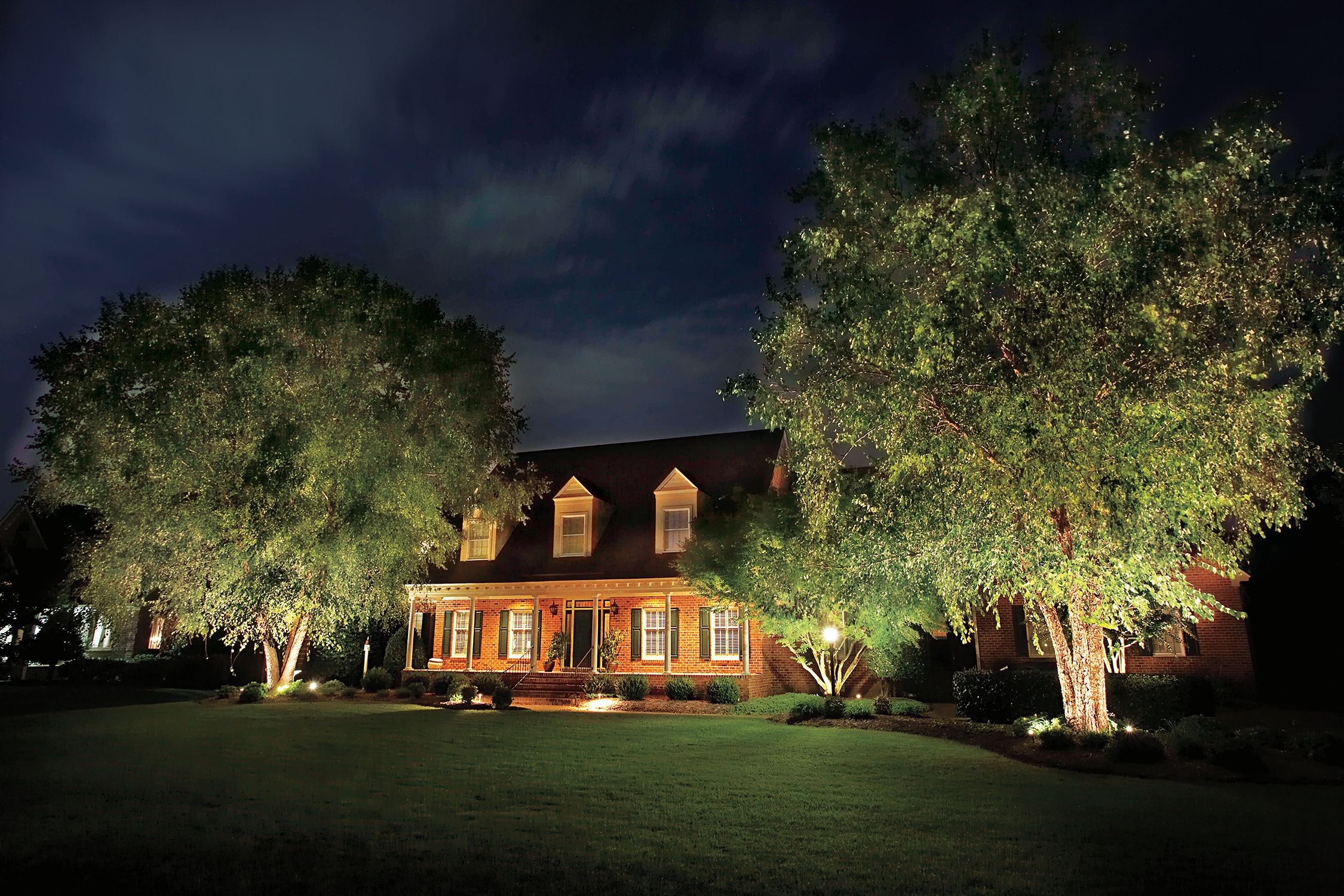
We encourage you to embrace environmentally conscious lighting choices. Opting for solar or low-voltage options reduces your carbon footprint and contributes to sustainable practices. By harnessing the sun’s rays or drawing energy efficiently, you can create stunning outdoor environments while preserving our planet’s beauty and resources. Illuminate your outdoor space with responsible, energy-efficient solutions for a brighter and greener tomorrow!
Frequently Asked Questions
What are the benefits of solar landscape lighting?
Solar landscape lighting offers several advantages, including energy efficiency, environmental friendliness, and reduced operating costs. These lights harness the sun’s rays to power their operation, making them a sustainable and renewable lighting option.
How does low-voltage landscape lighting work?
Low-voltage landscape lighting operates by using a transformer to lower the standard electrical voltage to a safer and more efficient level. This system allows for versatile lighting designs, longer fixture lifespan, and reduced energy consumption.
Are solar landscape lights suitable for all outdoor spaces?
Solar landscape lights are best suited for outdoor areas with sufficient daytime sunlight. They may not perform optimally in shaded or low-light environments.
Which is more cost-effective, solar or low-voltage landscape lighting?
The cost-effectiveness depends on location, electricity rates, and the initial investment. Solar lighting has lower operating costs over time, while low-voltage lighting may have higher upfront expenses but may perform better in specific scenarios.
Can solar landscape lights be used with existing electrical outlets?
Solar landscape lights do not require existing electrical outlets as they operate independently and rely solely on solar panels to generate energy. This makes them suitable for remote areas or locations without easy access to electrical power.
🌟🏞️ Explore Your Outdoor Oasis! 🌿🌞
Are you looking to transform your backyard into a stunning outdoor paradise? 🏡✨ BackYard Patio Life is your ultimate destination for landscaping and outdoor living.
Follow us on Facebook, Instagram, Pinterest, and Twitter to unlock a world of inspiration and creativity for your patio and garden.
🌳🌺 From solar vs. low voltage landscape lighting tips to DIY garden projects, we’ve got you covered! Join our vibrant community and discover the latest trends, expert advice, and jaw-dropping ideas to make your outdoor space the envy of the neighborhood. 🌼🌈 Take advantage of the fun! Follow Backyard Patio Life today! 🚀🌟
